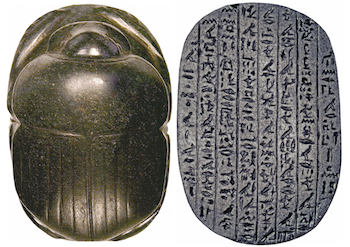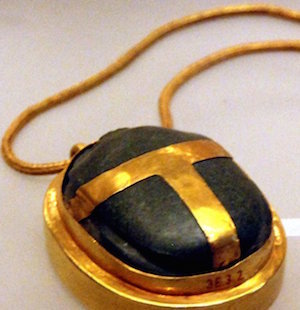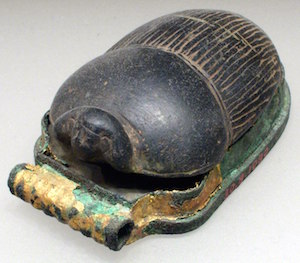The scarab was one of the most popular ancient Egyptian amulets. They were used as pieces of jewellery, commemorative items and seals, and magical amulets offering protection and good fortune. However, from the Middle Kingdom a specific type of scarab known as the Heart Scarab took on a very particular religious meaning and went on to become the most important amulet in the mummification and burial process.
The heart was seen as the home of the spirit, and the bodily element of the ancient Egyptian soul. In the Hall of Judgement, it was the heart which was weighed against the feather of Ma’at. If a person failed this test they would be devoured by Ammit, if they passed they would go on to enjoy a blissful afterlife. Unsurprisingly, the Egyptians were keen to protect their heart. The Heart Scarab was intended to protect the heart and act as a stand in for the heart of the deceased if it should be damaged.

The pragmatic ancient Egyptians also wanted to be sure that when they stood before Osiris and made the “Negative Confession”, their heart would not speak against them. The amulet was inscribed with Spells from the Book of the Dead, in particular Spell 30 which states:

O my heart which I had from my mother, O my heart which I had upon earth, do not rise up against me as a witness in the presence of the Lord of Things; do not speak against me concerning what I have done, do not bring up against me anything I have done in the presence of the Great God, Lord of the West (Osiris).


The earliest known scarab to have Spell 30 from the Book of the Dead is that of the thirteenth dynasty official Sobekhotep, and the earliest similar royal scarab is a beautiful gold and green jasper example made for the pharaoh Sobekemsaf II.


The amulet was usually carved in the shape of the scarab, representing the god Khepri who symbolised resurrection and rebirth. The heart scarab was also associated with mummification because the pupae of a scarab beetle resembles a mummy. The Egyptians also saw that the beetle would dig a shaft into the earth to bury its eggs, and the baby scarabs would later emerge from the earth. They associated this with the shaft leading into the burial chamber from which the reborn spirit would emerge.



The scarab was ideally formed from green or black stones, although examples in other colours have also been recovered. The silver scarab found in the Middle Kingdom tomb of Wah is of particular interest. Sometimes the scarab was set in gold, such as the green jasper and gold scarab of Hatnofer (father of Senenmut, New Kingdom) and the scarab of the pharaoh Sobekemsaf II. Occasionally, the amulet took the form of a human headed scarab, or a scarab with the head of another animal. Sometimes heart shaped amulets fulfilling the same function were inscribed with spell 30. From the late New Kingdom on, the scarab often had outstretched wings symbolising the protection it offered.
Bibliography
- Grajetzki, W (2003) Burial Customs in Ancient Egypt
- Ikram, Salima (1997) Death and Burial in Ancient Egypt
- Kritsky,Gene and Cherry, Ron (2000) Insect Mythology
- Pinch, Geraldine (2002) Handbook Egyptian Mythology
- Redford Donald B (2002) Ancient Gods Speak
- Teeter, Emily (2011) Religion and Ritual in Ancient Egypt
- Wilkinson, Richard H. (2003) The Complete Gods and Goddesses of Ancient Egypt
Copyright J Hill 2017